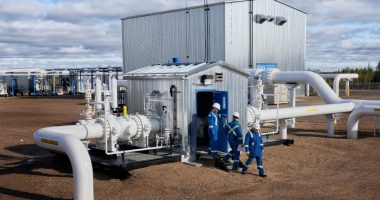Many countries across the world, including the United States and its new generation of modular reactors, are more and more looking towards a nuclear solution to solve their clean energy problems and accelerate decarbonization.
As nuclear energy grows, so too will the demand for uranium to fuel those reactors. That places the sector in a very interesting position because uranium is exiting a ten-year slump that shut down all but the very best exploration and development plays.
Fission Uranium’s focus lies in developing its high-grade, near-surface Triple R uranium deposit in Saskatchewan’s Athabasca Basin, the world’s leading source of high-grade uranium.
The Kelowna-based uranium developer’s award-winning PLS Project hosts the longest mineralized trend in the district, while Triple R is the only existing major, high-grade deposit in the region found at shallow depth.
Joining us today to dig into the world of uranium mining a little more is Fission Uranium President and CEO Ross McElroy.
TMH: To start off, give us a big-picture look at the uranium mining industry right now. Athabasca Basin. You say there’s a need to tap further into the Athabasca Basin. Why is that, and how are you positioned to take advantage of that?
RM: Sure. I think you touched on it in your introduction. Nuclear is such an important part of the clean energy plan going forward. In fact, there’s really no way forward to get to net zero carbon without going through nuclear. So we see it as an absolutely key player. The world is hungry for power, and it’s hungry for clean power. That’s where nuclear comes in. Canada’s a very important player in that a great deal of the world’s supply of nuclear fuel originates out of Canada’s Athabascan basin. So the northern part of the province of Saskatchewan that’s where we are located. FIssion has the property, the PLS property in the Athabascan Basin. It’s home to high-grade, large deposits, and you’re in a politically geopolitical secure district.
TMH: Let’s talk about your approach for a minute. You are developing the Triple R deposit. Talk a little about your progress over the last year from a technical and environmental aspect.
RM: Sure. Over the last year, well, actually, over the last 18 months or so, we embarked on our feasibility study. So we’ve now gone through all the initial steps of the economics and completed pre-feasibility in 2019. Really the goal for us here, and what we’ve really been focusing on in the last year, year and a half has been to upgrade the economic understanding of the project. We know this will be an underground mine. It’s near-surface, large, high grade, and the feasibility study is really all about the numbers and how we actually get it there and what’s the bottom line economics of it. So we’ve made great progress over the last while, and we’re really about two months out right now from having completed the feasibility study. So we’re in the final innings of getting that major piece of work done on the project.
TMH: Your management and operations team has some heavy hitters, including yourself as one of the sector’s top geologists. You’ve got ex-Cameco man, Gary Haywood who used to run the McArthur River Mine, and also Mark Wittrup, a top permitting and environment specialist with a 40-year background in uranium, including with the Saskatchewan government.
RM: Sure. No, it’s a fantastic team. It’s something that we’ve been focusing on for the last, I guess, probably two to three years building up our expertise in-house, bringing in the best of the best and those names that you just cited, Gary Haywood is our Vice President of project development. He joined us in 2021. He’s got a great depth of experience working for Cameco, working at McArthur River. He is a mining engineer with an unparalleled pedigree, and I think that that’s very, very important as we’re moving the project forward. So he’s heading up all of our feasibility study and really kind of quarterbacking most of the other aspects as well, and Mark Wittrup is a permitting guru, 30 years plus employee at Cameco responsible for putting uranium mines into production for Cameco, and he also worked on the other side too. He’s been in government with the ministry environment, he was, I guess, a deputy minister on that side. So he’s actually seen it from both sides. He knows what it looks like from the company’s perspective. He knows what it looks like from the government’s perspective, and he is absolutely a key player for us to be able to continue to move and navigate the regulatory environment as we go forward.
TMH: So, obviously, the corporate and the technical work is in very good hands. But we all know these days that mines need the right community support. Can you tell us about Fission’s community engagement?
RM: Yeah, it’s an aspect of the business that we focus a great deal on is community support and involvement. Really in Canada, it’s tough to imagine that you can get a project through the regulatory environment and the final approvals without having the support of the people in the community that live up in the area where you’re trying to develop your project. So I think, just speaking in general, Saskatchewan’s got a great track record of local support. We have a number of different indigenous bands in the area, First Nations and Metis, and a key part of our work is making sure that we have good, transparent, respectful, and meaningful relationships. We’ve got to look in the long term. We want to be the economic engine of the area and be able to provide those jobs and service spinoffs that are associated with it, and having the community and their constituents supporting the project, I think, is absolutely key.
TMH: You released some important results towards the end of summer. You have increased your indicated resources by more than 20%, is that right? And your deposit still remains open in multiple directions, and you do have two other mineralized zones. What does that mean for Fission?
RM: Sure. Yeah. I mean, the resource update was a very important part of our equation because what we were working on was converting the key part of the deposit that was classified as inferred. We wanted to bump it up to indicated, once it’s at indicated, then we have the ability to bring it into the mine plan. So what was key for us in that equation was to bring in another zone. The deposits are made up of five zones. We wanted to bring in the second largest zone, the R840 West, and so by adding 24 or 25 holes into it in 2021, we’ve been able to substantially increase the overall indicated resource and add flexibility too with the mine plan. So that was a key part of our work ahead of us. We wanted just a bigger, more robust resource to be able to work the feasibility study that will have an impact on the overall mine life and should affect the overall bottom line economic numbers as well.
TMH: And you hope to deliver a feasibility study before the end of the year? What’s the status of that and unpack how big a milestone that is for your company?
RM: Sure. Well, we’re on target to complete it by the end of 2022. So we’re expecting to be able to wrap it up by mid-December, it may stretch out to the first week of January, but it’s really that timeframe, two months from now, two months or less, I think we’re going to be in a position to complete. It’s an absolutely huge milestone for us. I mean, it’s the major economic study, and it’s the one where we understand how it is that we will mine this deposit. What are the costs involved with it? What are the assumptions made? So a very, very detailed engineering report on how we get the project moving forward. It’s for any company, a feasibility study is an absolutely critical, major, major milestone, and for us, it’s no different. It’s just one in a number of avenues that we have going forward, but it’s absolutely key at this stage of the project to get a good solid feasibility study behind us.
TMH: Is there anything else you maybe haven’t touched on yet that is important for our viewers and, of course, your investors to know?
RM: I think we’ve touched on a lot of issues, but I would just highlight again the importance for me, what it always comes down to is you’re looking for strong management that has the background to be able to move projects forward in the business that you’re in, Fission has that. You want to be a tier-one asset, which we have, we have one of the strongest and best uranium projects out there. It’s a development project. It really has no equal, and you want to be in a tier one jurisdiction, and that’s really what the province of Saskatchewan is. So tier-one asset, tier-one jurisdiction, top management, those are always aspects that I think people need to focus on.
TMH: Now, there is the possibility of filing the Environmental Impact Assessment in 2023 Where does that initiative stand and what does that mean for the company?
RM: Yeah, so the next major regulatory and permitting part of the equation is to file the environmental impact study. That we anticipate being in a position to file by Q3 of 2023. So for us, it is getting the feasibility study completed, working on further securing agreements with our local indigenous partners in the area and getting ready to go forward on the EIS. Now, the EIS, the environmental impact study that is, I guess, the big permitting review portion of the project coming out of that is where you will receive licenses to build your project and operate. So it’s a key critical part of the equation. We’re anticipating just getting right into it by about Q3 2023
Thanks again for joining us at The Market Herald today Ross, we look forward to keeping an eye on things and chatting with you again soon.
We’ve been speaking with Ross McElroy, the President and CEO of Fission Uranium. The company trades on the TSX under the ticker symbol FCU and the OTCQX under the symbol FCUUF. You can also visit fissionuranium.com/ for more information. Once again, I’d like to thank Ross for joining us today to learn more about his company’s latest developments and share his insights with our Top Line audience and his investors.
FULL DISCLOSURE: This is a paid article produced by The Market Herald.




